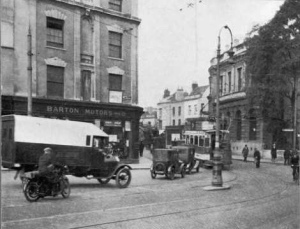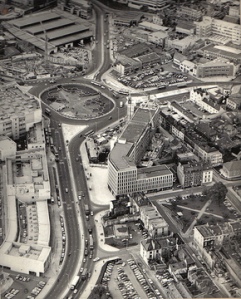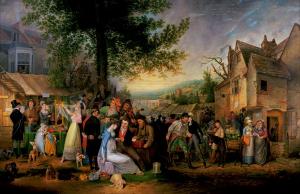The Bear Pit (aka the sunken pedestrian precinct in the centre of the St James Barton Roundabout) is not just ugly and neglected – it is contagious. Unloved, neglected and dismal it is infecting the buildings and the space around it. The shops on its south side, even the distinguished Debenhams’ buildings, are shabby and turn their backs on the Bear Pit, preferring to put their effort into the shop fronts on Horsefair. The new Cabot Circus shopping centre makes no pretence of its dismay. From the roundabout the sheer and windowless back wall of the multiplex cinema is all you can see of the hundreds of millions of pounds poured into this development.
To the north, the laughably bad 5102 (aka Avon House home to the unloved and short-lived Avon County Council) has been clad, armoured, gated and wired, while the west wing of the development is now reduced to its empty concrete shell. Together they act as a curtain wall, shielding the city centre from the bad lands of Stokes Croft and St. Paul’s. The new coach station on Malrborough Street is invisible; though given what it looks like this may be no bad thing. Yet this, to all intents and purposes, is where the M32 ends and those arriving by car enter the city; unless of course they just pass on the whole Bristol experience and turn off early for the hermetically sealed worlds of car parks and shopping in Cabot.
Before the bombing raids of 1940 and 1941 St James Barton was a bustling, if already rundown, Victorian commercial zone. With much of the neighbourhood reduced to rubble it sat untouched for much of the 1950s. When the council finally got around to redeveloping it in the 1960s, it had been reduced in their imagination to a transport intersection. In the early 1960s a street level traffic island was in place, but in the late 1960s under the influence of the Buchannan Report “Transport in Towns”, the council pursued the new planning common sense that accepted the rapid motorisation of British cities and sought to separate pedestrian from the cars rather than control the later.
There was, I suspect, just a hint of Corbusier’s utopianism in the plan. The Bear Pit was if not quite a streets in the sky, meant to be a place that would be used and paused over. As Jim Dixon has shown in his brilliant archaeology of the benches in the Bear Pit, the initial vision was friendly: large back to back benches. These were replaced by fewer and more dispersed benches in response to the declining football through the pit. Finally, the current street furniture, all single chairs and benches you can’t lie on , are designed to exclude the homeless and encourage everyone else to just pass on by. The many layers of confused and ancient signage speak to the steady decline of a public space that would not conform to its original intentions.
Repeated interventions and plans from the council, including proposals for a £4million shopping redevelopment, have come to nothing. Given that in the current economic climate neither property developers nor public bodies have the money or the ideas to take on the Bear Pit, it’s over to civil society The recently formed Bear Pit Improvement Group is bringing together a range of interested parties, including PRSC, to think creatively about what can be done. Proposals include crating surface crossings, installing artist’s zones, traders, cafes and kiosks.
I’ll be returning to the details in later blogs, but first it’s worth thinking about what makes people give a damn about a place? Of course, we care about a place for lots of reasons, like civic spirit and economic interests, but neither has worked too well for the Bear Pit. Maybe we should try a little and memory and meaning? One of the consequences of the redevelopment of St James Barton was to wipe any remnant of its long history from the landscape. The medieval church from which the area takes it same is now hidden away behind the lumbering bulk of the Premier Inn’s tower. For most of the last six hundred years the land on which the Bear Pit sits was part of a large churchyard, part graveyard, part field. This was the site of the infamous Bristol Fair, which was held annually from to 1837, when the riotousness and licentiousness of traders and public alike saw it banned. As well as horse and feed markets on Horsefair and Haymarket to the south, the fair boasted entertainments, ale houses, freak shows and boxing booths. In 1807 there are reports of a wild menagerie featuring tapirs and kangaroos.
As John Latimer, the great Victorian chronicler of Bristol history described it:
Blankets and woollens from Yorkshire, silks from Macclesfield, linens from Belfast and Lancashire, carpets from Kidderminster, cutlery from Sheffield, hardware from Walsall and Wolverhampton, china and earthenware from Staffordshire and other counties, cotton stockings from Tewkesbury, lace from Buckinghamshire and Devon, trinkets from Birmingham and London, ribbons from Coventry, buck and hog skins for breeches, hats and caps, millinery, haberdashery, female ornaments, sweetmeats and multitudinous toys from various quarters arrived in heavily laden wagons and were joined by equally large contributions from the chief industries of the district.
To these again were added nearly all the travelling exhibitions and entertainments then in the country – menageries, circuses, theatres, puppet shows, waxworks, flying coaches, rope-dancers, acrobats, conjurors, pig-faced ladies, living skeletons, and mummers of all sort who attracted patrons by making a perfect din. It need scarcely be added that the scene attracted a too plentiful supply of pickpockets, thieves, thimble-riggers and swindlers of every genus.
Now if that’s not the starting point for reimagining and reinventing the Bear Pit, I don’t know what is.




We in the Bristol Traffic project are great fans of the Bear Pit, and dream of a return to its 1970s glory. How can we help?
Again, thank you so much for another great piece. Yes, yes, yes………all good wishes to everyone working to improve this space and reclaim it for the future. I first moved to Bristol in 1966 – it wasn’t quite as bad then but deteriorated year on year, exactly as you describe.
The 5102 building does not act as a ‘curtain wall’! It is a building! That you can drive or walk under! What utter drivel! I used to have a friend in that building and can’t for the life of me work out where the nonsense about it being ‘gated’ comes from! You enter the building through a glass door on the street on the corner, just like almost every other apartment block on the face of the earth! The part that is gated and ‘wired’ is the car park! That’s because it’s a car park! In a major city centre! Get a grip and stop feeling sorry for yourselves! The reason the area is a dump is because of the luddite left-wing stereotypes that seem determined to cut the whole place off from the rest of society (maybe because they don’t want to admit that they can’t quite cut it in the real world!)
Well said Marcus, I wonder if the owner of this page has a lock on his front door or a gated house (this is what they call them round here) that turns its back on the road in which he lives when he shuts the doors.
If he owns a car he might even have a gated garadge!
The 51’02 won an award for the way in which the building was converted from a defunk office block to flats, and looks a lot better than it did before it was converted! I bet the residents of the 105 flats in that building pay more income tax than the whole of stokes croft & st james barton combined!
Im not suggesting that this makes the residents any better than anyone else, but they do often get a hard time on this site and there is no doubt that they probably contribute far more to society than others who live in this area.
The bear pit needs to be filled in, the police allow people with problems to hang around in the area, they’ve got to go somewhere I suppose!